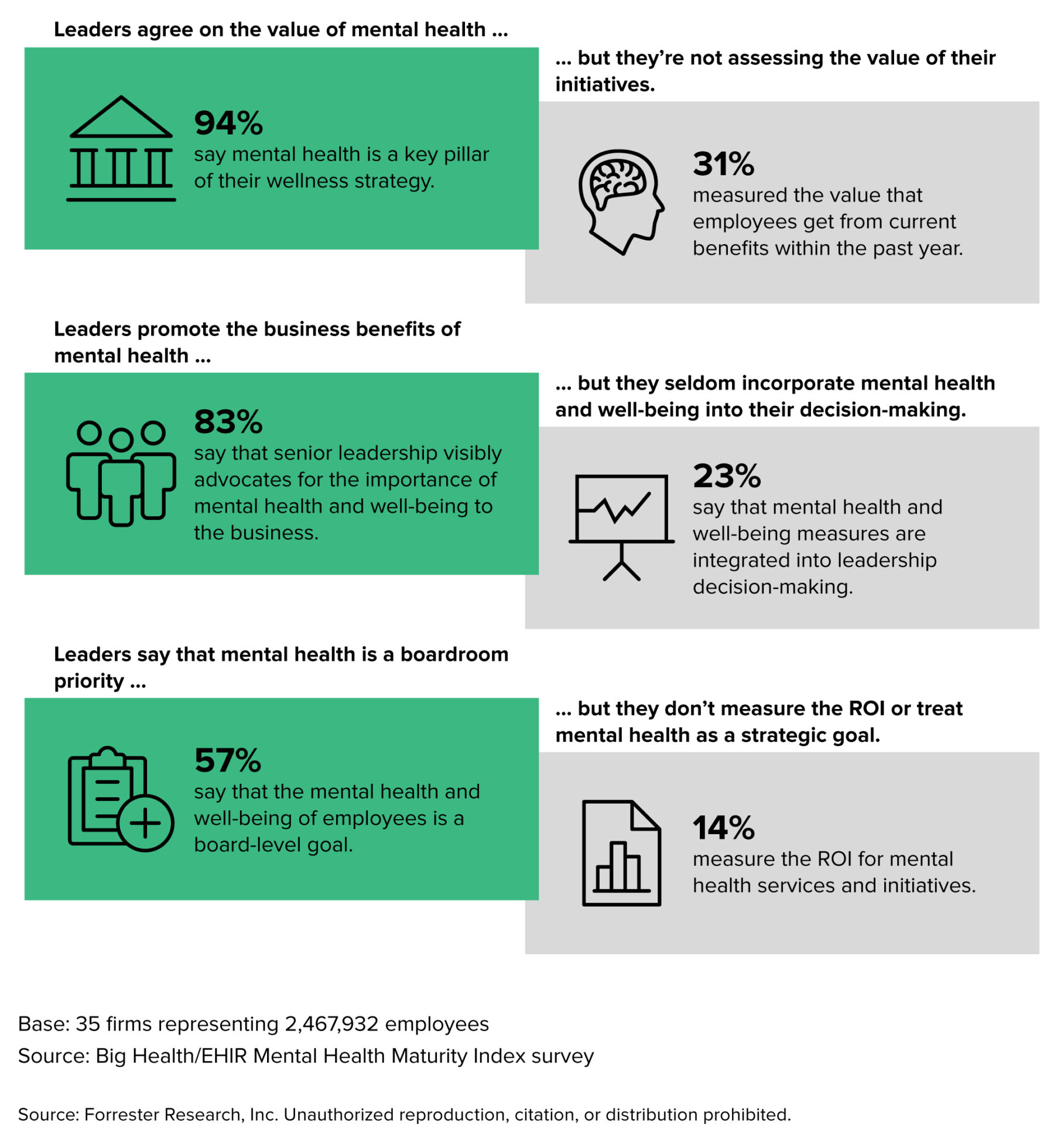The State Of Employer Mental Health Support In 2021: Employers Need To Do A Better Job For Their Employees
Employees faced significant issues in access and affordability of mental health services long before the pandemic. Amid a pandemic, the need for mental health support escalated to unprecedented levels. In the past year, 83% of US employees experienced negative emotions associated with poor mental health, yet many employers have taken no action. Only 21% of purchase influencers at firms that prioritize employee experience reported that they’re implementing employee well-being and mental health programs. According to FAIR Health claims data, mental health conditions continued to be the number one telehealth diagnosis nationally and in every region. Ignoring the need now will result in significant business impact across employee engagement, absenteeism, presenteeism, medical spend, and disability claims.
Our report, “The State Of Employer Mental Health Support,” provides insight into how the employer market is performing when it comes to employee mental health. This milestone report sets the tone for future benchmarking efforts on the industry and helps uncover where companies can improve their efforts to empower employees to bring their “whole selves” to work. Many of the data points referenced in our report are from Big Health’s Mental Health Maturity Index (BHMHMI) survey of 35 large US-based employers, representing nearly 2.5 million employees across the globe. The survey was co-led by Big Health and the Employer Health Innovation Roundtable (EHIR) and sheds a light on the different dimensions in the large disconnect that exists between senior management and workers within organizations when it comes to employee mental health.

Take These Necessary Steps To Drive Systemic Improvement For Employees
Investment in mental health is a new priority for many employers, but slow movement to support mental health impacts employee and customer experience and puts business resiliency at risk. In the report, Forrester identified seven key steps that firms must take to help course-correct and continue to accelerate their mental health efforts. Here are a few of them to help your firm get started:
- Establish a self-assessment process to help employees connect to the right resources. In the survey, only 49% of firms indicated that a self-assessment process was available. Mental health isn’t one-size-fits-all: You must give workers the right tools that best fit their individual needs to drive employee engagement across the company.
- Train managers to detect employee mental health needs early. Only 34% of firms in the survey indicated that they provided training for managers in this regard. Managers can act as a first line of defense, detecting early onset of burnout and the need for more support.
- Develop a strategy to identify and engage silent sufferers. The Anxiety and Depression Association of America found that only 37% of those suffering from anxiety receive treatment. Observation and early detection of employee distress are key; managers are a reliable point of consistent contact for employees, and they often notice changes before employees do.
- Promote mental health programs to break through the stigma of getting help. Fewer than 50% of firms in the survey have run an anti-stigma campaign in the past year. Firms should share information via email campaigns, the company intranet, and even managers in team meetings.
- Address the lack of equity in mental health to bolster diversity and inclusion efforts. A more inclusive mental healthcare model will provide employees with the right care — when and how they need it. Firms should leverage in-person care, which is essential for severe mental health needs and individuals who are disconnected by the digital divide. Digital tools can connect employees with a diverse set of providers and ensure access to culturally competent care that may not be accessible in their area.
Start By Determining Metrics, Communication Plans, And Accountability
When evaluating the performance of their mental health investments, employers must choose metrics that track the business impact, activities completed, and the outcomes of those activities. To gain attention and budget for an investment, estimate the potential financial returns and qualitative benefits for leadership. The most common economic indicators that firms assess are the impact on disability claims, healthcare costs, absenteeism, and retention. Start writing your business case with Forrester’s Employee Mental Health Benefit Calculator.
Check out the full report here.
Want to read more of Forrester’s mental health coverage? Check out more here.
Have questions about this report or our coverage of mental health? Set up an inquiry.
– – –
Related Resources
- Being Well At Work Makes Work Go Well
- How To Calculate The Benefits Of An Employee Mental Health Program
- Employee Mental Health Must Be Front And Center For Every Employer
- Warning: Employee Engagement Is Higher Than You Think — Carefully Monitor The Burnout Factor
- Build A Culture Of Emotionally Intelligent Employees To Boost Mental Health
- Employee Experience Is A Business Imperative
